
The Acropolis of Athens is an ancient citadel located on a rocky outcrop above the city of Athens, Greece, and contains the remains of several ancient buildings of great architectural and historical significance, the most famous being the Parthenon. The word Acropolis is from the Greek words ἄκρον and πόλις. The term acropolis is generic and there are many other acropoleis in Greece. During ancient times the Acropolis of Athens was also more properly known as Cecropia, after the legendary serpent-man Cecrops, the supposed first Athenian king.

The Parthenon is a former temple on the Athenian Acropolis, Greece, that was dedicated to the goddess Athena. Its decorative sculptures are considered some of the high points of classical Greek art, and the Parthenon is considered an enduring symbol of Ancient Greece, democracy, and Western civilization.

Phidias or Pheidias was an Ancient Greek sculptor, painter, and architect, active in the 5th century BC. His Statue of Zeus at Olympia was one of the Seven Wonders of the Ancient World. Phidias also designed the statues of the goddess Athena on the Athenian Acropolis, namely the Athena Parthenos inside the Parthenon, and the Athena Promachos, a colossal bronze which stood between it and the Propylaea, a monumental gateway that served as the entrance to the Acropolis in Athens. Phidias was the son of Charmides of Athens. The ancients believed that his masters were Hegias and Ageladas.

The Gorgons, in Greek mythology, are three monstrous sisters, Stheno, Euryale, and Medusa, said to be the daughters of Phorcys and Ceto. They lived near their sisters the Graeae, and were able to turn anyone who looked at them to stone. Euryale and Stheno were immortal, but Medusa was not and was slain by the hero Perseus.
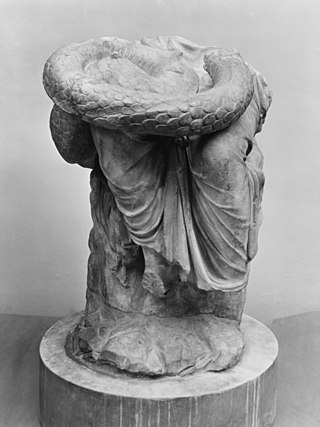
Hygieia is a goddess from Greek mythology. Hygieia is a goddess of health, cleanliness and hygiene. Her name is the source for the word "hygiene".

The statue of Athena Parthenos was a monumental chryselephantine sculpture of the goddess Athena. Attributed to Phidias and dated to the mid-fifth century BCE, it was an offering from the city of Athens to Athena, its tutelary deity. The naos of the Parthenon on the acropolis of Athens was designed exclusively to accommodate it.
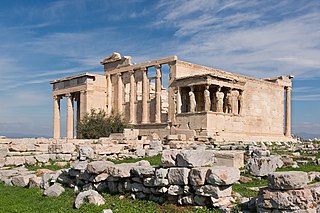
The Erechtheion or Temple of Athena Polias is an ancient Greek Ionic temple on the north side of the Acropolis, Athens, which was primarily dedicated to the goddess Athena.
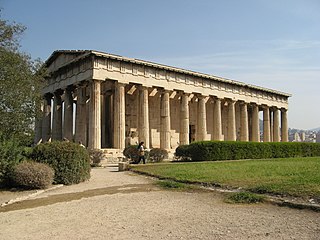
The Temple of Hephaestus or Hephaisteion, is a well-preserved Greek temple dedicated to Hephaestus; it remains standing largely intact today. It is a Doric peripteral temple, and is located at the north-west side of the Agora of Athens, on top of the Agoraios Kolonos hill. From the 7th century until 1834, it served as the Greek Orthodox church of Saint George Akamates. The building's condition has been maintained due to its history of varied use.
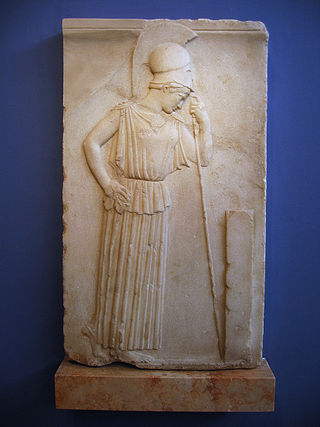
A peplos is a body-length garment established as typical attire for women in ancient Greece by c. 500 BC, during the late Archaic and Classical period. It was a long, rectangular cloth with the top edge folded down about halfway, so that what was the top of the rectangle was now draped below the waist, and the bottom of the rectangle was at the ankle. One side of the peplos could be left open, or pinned or sewn together. In Latin and in a Roman context, it could be called a palla.
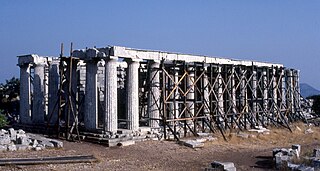
Bassae is an archaeological site in Oichalia, a municipality in the northeastern part of Messenia, Greece. In classical antiquity, it was part of Arcadia. Bassae lies near the village of Skliros, northeast of Figaleia, south of Andritsaina and west of Megalopolis. It is famous for the well-preserved mid- to late-5th century BC Temple of Apollo Epicurius.

The Athena Promachos was a colossal bronze statue of Athena sculpted by Pheidias, which stood between the Propylaea and the Parthenon on the Acropolis of Athens. Athena was the tutelary deity of Athens and the goddess of wisdom and warriors. Pheidias also sculpted two other figures of Athena on the Acropolis, the huge gold and ivory ("chryselephantine") cult image of Athena Parthenos in the Parthenon and the Lemnian Athena.

The metopes of the Parthenon are the surviving set of what were originally 92 square carved plaques of Pentelic marble originally located above the columns of the Parthenon peristyle on the Acropolis of Athens. If they were made by several artists, the master builder was certainly Phidias. They were carved between 447 or 446 BC. or at the latest 438 BC, with 442 BC as the probable date of completion. Most of them are very damaged. Typically, they represent two characters per metope either in action or repose.
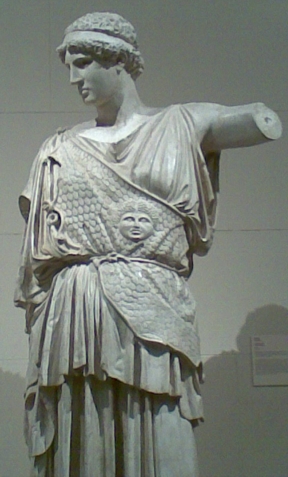
The Lemnian Athena, or Athena Lemnia, was a classical Greek statue of the goddess Athena. According to geographer Pausanias (1.28.2), the original bronze cast was created by the sculptor Phidias circa 450–440 BCE, for Athenians living on the island of Lemnos to dedicate on the Acropolis of Athens.

The Acropolis Museum is an archaeological museum focused on the findings of the archaeological site of the Acropolis of Athens. The museum was built to house every artifact found on the rock and on the surrounding slopes, from the Greek Bronze Age to Roman and Byzantine Greece. The Acropolis Museum also lies over the ruins of part of Roman and early Byzantine Athens.

In Greek mythology and ancient religion, Nike is the goddess who personifies victory in any field including art, music, war, and athletics. She is often portrayed in Greek art as "Winged Victory" in the motion of flight; however, she can also appear without wings as "Wingless Victory" when she is being portrayed as an attribute of another deity such as Athena.

The Piraeus Athena is a bronze statue dated to the fourth century BCE. It currently resides in the Archaeological Museum of Piraeus.
The Angelitos Athena is an ancient marble statue, which was made around 480–470 BC. The figure, the earliest known depiction of the armed Athena, is an example of the severe style, the transitional style between archaic and classical Greek sculpture which developed after the Persian Wars. Today it is located at the Acropolis Museum under the inventory number 140.

The Lenormant Athena is the name given to a small Greek statuette which was made in the first century CE.
The Athena with cross-strapped aegis is an ancient statue of the Greek goddess Athena, which was made around AD 150 and is now displayed in the Antikensammlung Berlin.

The pediments of the Parthenon are the two sets of statues in Pentelic marble originally located as the pedimental sculpture on the east and west facades of the Parthenon on the Acropolis of Athens. They were probably made by several artists, including Agoracritos. The master builder was probably Phidias. They were probably lifted into place by 432 BC, having been carved on the ground.



















